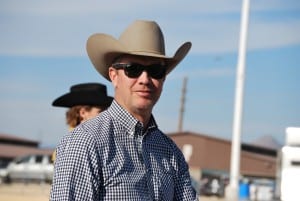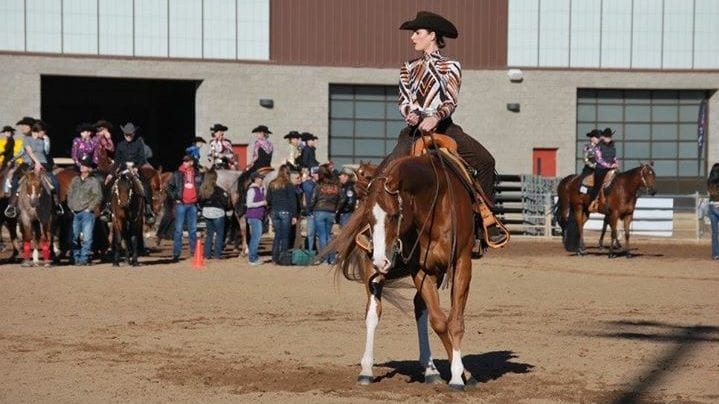As western horsemanship grows ever more popular, the competition level has also increased. With such stiff competition, it is essential to make every single element in your pattern count. Horsemanship patterns are also starting to grow in the degree of difficulty, but it is important to remember the fundamentals of a pattern. A single-speed change or even a back could diminish your chances of bringing home the coveted ribbon. One of the most critical elements that will make or break a pattern is the spin.
In a horsemanship class, exhibitors may be asked to perform multiple turns in one pattern alone. The rider should show a slight hesitation before completing the turn asked of them, usually in increments of 90°, most commonly 270° and 360°. Keeping a poised position with barely visible cues, the horse should respond immediately and turn on its haunches in the direction the pattern described.
In recent years, we have seen a shift from slower spins to quicker, less controlled spins. But how important is the speed of the turn? Can a rider’s ability overshadow a less than perfect spin? Do judges reward a fast, incorrect spin over a slower, correct one?
We asked a few of today’s AQHA judges and trainers what they preferred to see in the show arena.
 Brad Ost of Empyre Show Horses grew up in North Idaho and specializes in western all-around events with his partner Troy Lehn. Ost commented that “A credit-earning spin is one that maintains correctness over speed. Adding speed to that correct turn is great, as long as you do not lose your accuracy. A correct turn should maintain forward motion, with crossing over in the front, while staying stationary and balanced in the hind end,” Ost stated.
Brad Ost of Empyre Show Horses grew up in North Idaho and specializes in western all-around events with his partner Troy Lehn. Ost commented that “A credit-earning spin is one that maintains correctness over speed. Adding speed to that correct turn is great, as long as you do not lose your accuracy. A correct turn should maintain forward motion, with crossing over in the front, while staying stationary and balanced in the hind end,” Ost stated.
Also, while speaking with Brett Clark, an AQHA Judge and professional horseman based out of North Dakota, he stated his opinion by taking it back to the fundamentals of the class. “Horsemanship is a class based on a rider’s ability to control a horse with western tack,” Clark explained.

Adding to that, “The most important fact of a spin is how the rider rides the spin, which means how they sit and control the horse through the maneuver. That being said, if a rider is doing a good job, the spin should be correct. Correctness first, then speed after. As a judge, I am always careful to reward the rider who controls their horse the best. Not just the rider with the horse that spins the best regardless of the rider’s cues.”
Finally, Mike Hoeppner, who is an AQHA Professional Horseman and judge from Whitesboro, Texas, stated, “As a judge, I believe in the hierarchy principles of #1- Correctness #2 – Quality #3-Degree of Difficulty. In coaching my clients, I stress correctness of the turns first in holding the pivot foot and keeping smoothness in the footwork of the turn to preserve the quality of the turn. Then, we can add speed as the horse and rider team gets more comfortable with the maneuver. As a judge, I can not give maximum credit for the maneuver if the horse loses control of the rear end at higher speeds.”
 Hoeppner continues, “Also, the way a rider maintains their balance and shows an ability to control the maneuver to the next maneuver plays a big part in scoring the turn. Speed without control is detrimental to the overall presentation of the pattern.”
Hoeppner continues, “Also, the way a rider maintains their balance and shows an ability to control the maneuver to the next maneuver plays a big part in scoring the turn. Speed without control is detrimental to the overall presentation of the pattern.”
He adds, “I believe that the trend in spins can partly be attributed to many of theses horses showing in the trail as well as horsemanship. As a trainer, it is hard to teach a horse a correct spin and an excellent turn in the box. I do firmly believe that speed without control and correctness should be penalized in that maneuver score. So as judges, we need to encourage and reward correctness and discourage speed as the only factor.”
In summary, a slower, correct spin will be rewarded over a faster turn that shys away from the age-old structure of the horsemanship element. Because of this, when practicing horsemanship, it is vital to remember the fundamentals and take it back to the basics. Focus on creating a fundamentally sound maneuver before increasing the speed. It will be sure to pay off in the show pen.







